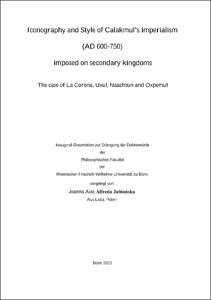Iconography and Style of Calakmul's imperialism (AD 600-750) imposed on secondary kingdomsThe case of La Corona, Uxul, Naachtun and Oxpemul

Iconography and Style of Calakmul's imperialism (AD 600-750) imposed on secondary kingdoms
The case of La Corona, Uxul, Naachtun and Oxpemul

| dc.contributor.advisor | Źrałka, Jarosław | |
| dc.contributor.author | Jabłońska, Joanna Asia Alfreda | |
| dc.date.accessioned | 2023-06-02T12:46:00Z | |
| dc.date.available | 2023-06-02T12:46:00Z | |
| dc.date.issued | 02.06.2023 | |
| dc.identifier.uri | https://hdl.handle.net/20.500.11811/10871 | |
| dc.description.abstract | Calakmul was the seat of the Kanu'l dynasty (The Snake) during the Late Classic period, one of the most important and powerful dynasties of all the Classic Maya dynasties. The Kanu'l dynasty's desire to rule over smaller cities was met in the sixth century by the response from its main rival, Tikal. Victories over Tikal and its vassals in the sixth and seventh centuries led to the establishment of a widespread overkingship by the Kanu'l dynasty, whose influence extended to all parts of the Maya Lowlands.
Although the Snake dynasty was never considered an empire, it employed some imperial strategies to incorporate smaller sites into its sphere of influence. One of these strategies was the cooptation of local rulers. Archaeologically, this can be seen in the imitation of imperial styles. The introduction of the Kanu'l style to other sites was mainly based on the adoption and repetition of the same art conventions and symbols. The Kanu'l dynasty paid particular attention to visual representations as a means of political control, propaganda and the dissemination of ideologies and ideas. So far, little is known about how the incorporation of centres located in close proximity to Calakmul changed their use of style and symbol system. Paired stelae and ballgame panels at Uxul, Naachtun, La Corona and Oxpemul follow an iconographic programme known from other sites under Kanu'l dynasty rule. Areas far from Calakmul may have emulated this imperial style as very prestigious or powerful, but in the case of towns close to it, this is usually seen as evidence of political control. Nevertheless, there is much diversity among Uxul, La Corona, Naachtun and Oxpemul in terms of the chronology of the paired stelae and ballgame panels, their location, and the postdepositional processes. All these factors suggest that different dynamics (imitation, cooption, forced adoption/imposition) are reflected in the iconographic practises of these centres. My case study is also a good example of how a superstate uses iconography as a means of asserting power and domination and how its subordinates responded to its imperial politics. | en |
| dc.language.iso | eng | |
| dc.rights | Namensnennung 4.0 International | |
| dc.rights.uri | http://creativecommons.org/licenses/by/4.0/ | |
| dc.subject | Calakmul | |
| dc.subject | Imperialismus | |
| dc.subject | Ikonographie | |
| dc.subject | La Corona | |
| dc.subject | Naachtun | |
| dc.subject | Uxul | |
| dc.subject | Oxpemul | |
| dc.subject | the Snake Dynasty | |
| dc.subject | Iconography | |
| dc.subject | Imperialism | |
| dc.subject.ddc | 390 Bräuche, Etikette, Folklore | |
| dc.subject.ddc | 700 Künste, Bildende Kunst allgemein | |
| dc.subject.ddc | 970 Geschichte Nordamerikas | |
| dc.title | Iconography and Style of Calakmul's imperialism (AD 600-750) imposed on secondary kingdoms | |
| dc.title.alternative | The case of La Corona, Uxul, Naachtun and Oxpemul | |
| dc.type | Dissertation oder Habilitation | |
| dc.publisher.name | Universitäts- und Landesbibliothek Bonn | |
| dc.publisher.location | Bonn | |
| dc.rights.accessRights | openAccess | |
| dc.identifier.urn | https://nbn-resolving.org/urn:nbn:de:hbz:5-70970 | |
| ulbbn.pubtype | Erstveröffentlichung | |
| ulbbn.birthname | Dudek | |
| ulbbnediss.affiliation.name | Rheinische Friedrich-Wilhelms-Universität Bonn | |
| ulbbnediss.affiliation.location | Bonn | |
| ulbbnediss.thesis.level | Dissertation | |
| ulbbnediss.dissID | 7097 | |
| ulbbnediss.date.accepted | 15.12.2022 | |
| ulbbnediss.institute | Philosophische Fakultät : Institut für Archäologie und Kulturanthropologie (IAK) | |
| ulbbnediss.fakultaet | Philosophische Fakultät | |
| dc.contributor.coReferee | Graham, Elizabeth | |
| ulbbnediss.contributor.orcid | https://orcid.org/0000-0001-5246-5916 | |
| ulbbnediss.contributor.gnd | 1329644263 |
Dateien zu dieser Ressource
Das Dokument erscheint in:
-
E-Dissertationen (702)




